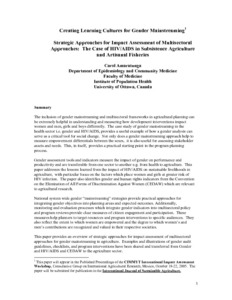Creating learning cultures for gender mainstreaming
Abstract
The inclusion of gender mainstreaming and multisectoral frameworks in agricultural planning can be extremely helpful in understanding and measuring how development interventions impact women and men, girls and boys differently. The case study of gender mainstreaming in the health sector i.e. gender and HIV/AIDS, provides a useful example of how a gender analysis can serve as a critical tool for social change. Not only does a gender mainstreaming approach help to measure empowerment differentials between the sexes, it is also useful for assessing stakeholder assets and needs. This, in itself, provides a practical starting point in the program planning process. Gender assessment tools and indicators measure the impact of gender on performance and productivity and are transferable from one sector to another e.g. from health to agriculture. This paper addresses the lessons learned from the impact of HIV/AIDS on sustainable livelihoods in agriculture, with particular focus on the factors which place women and girls at greater risk of HIV infection. The paper also identifies gender and human rights indicators from the Convention on the Elimination of All Forms of Discrimination Against Women (CEDAW) which are relevant to agricultural research. National system wide gender �??mainstreaming�?� strategies provide practical approaches for integrating gender objectives into planning areas and expected outcomes. Additionally, monitoring and evaluation processes which integrate gender indicators into multisectoral policy and program reviews provide clear measures of citizen engagement and participation. These measures help planners to target resources and program interventions to specific audiences. They also reflect the extent to which women are empowered and the degree to which women�??s and men�??s contributions are recognized and valued in their respective societies. This paper provides an overview of strategic approaches for impact assessment of multisectoral approaches for gender mainstreaming in agriculture. Examples and illustrations of gender audit guidelines, checklists, and program interventions have been shared and transferred from Gender and HIV/AIDS and CEDAW to the agriculture sector

